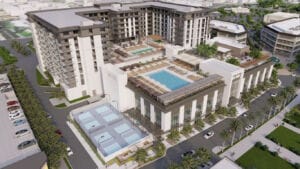Downtown Phoenix development may provide opportunities, but for some residents, the construction has only made it harder to find an affordable place to live.
By 2020, the Downtown Phoenix population is predicted to grow from 17,000 to 18,384.
According to Sara Scoville-Weaver, Business Development Manager at Downtown Phoenix Inc., the population growth has created a 5.8 percent increase in rental prices.
Since 2004, $5.5 billion has been invested into the development of downtown Phoenix alone.
“We see growth as a positive thing,” she said. “A strong urban core benefits the whole city.”
Some consider the development to be a sign of progress and opportunity while others call it a form of gentrification.
“Most of the development I see, the kind that concerns me, is not coming from or considering the community it impacts,” said Lauren Kennedy, art teacher at Chavez Leadership Academy in South Phoenix. “I am the picture of the gentrification that I critique: an upper-class middle-class white woman who moved downtown from out of state.”
With the population of Phoenix quickly increasing, the city has expanded the bus system. Now, the city is expanding the light rail. For some people, this expansion may make it easier to access jobs. For Syndi Flores, an Arizona State University alumni and fifth-grade teacher at Cesar Chavez Leadership Academy, it has a completely different meaning.
After the light rail was expanded into her neighborhood, Flores’ mobile home park in Tempe was shut down due to redevelopment. She scrambled to find a new residence within her budget. Before the construction, Flores had lived in same area for over 20 years. She said the high prices will force people to move to different parts of the city.
“Affordable areas are becoming harder and harder to find,” Flores said. “They are not working with people’s budgets and the light rail and development are making the prices go up.”
“We are working to provide affordable housing,” Scoville-Weaver said. “Construction prices and land prices are super high right now. In order to put in affordable housing, it becomes kind of a balancing act.”
Amy Otto, Program Manager at Roosevelt Row Community Organization, says responsible and irresponsible development in Phoenix has created challenges but also provides opportunities for people in the community.
Downtown Phoenix has created a platform for new artists and vendors to perfect their craft and explore their creativity. Although First Friday has grown in popularity, artists that built the district and basically made it cool are the same artists that aren’t able to live and perform the way that they have before due to the rising prices— it depends on your perspective, Otto said.
According to Otto, the downtown Roosevelt Row district used to have cheap rent on places that were not classified as residential. Artists lived with less regulated property taxes and rent prices.
“I think that we definitely want to try to create residential spaces that take into account lower income artists and students,” Otto said. “I think that will always be a challenge in an urban environment. We have an engaged community that want to see a mix of income levels and professional-type people mixed with artists mixed with students and mixed with families. When people come together, a lot of big things happen.”
She supports “long-term development,” sustainable apartments with units sold at a mixed-rate for residents at different income levels.
“Development isn’t bad and the rent increase isn’t inherently bad,” Kennedy said. “However, if we want development to support everyone in the community, then we need to develop from within the community, provide equal education and economic activities in all neighborhoods and support local businesses that reflect the face of the community.”



